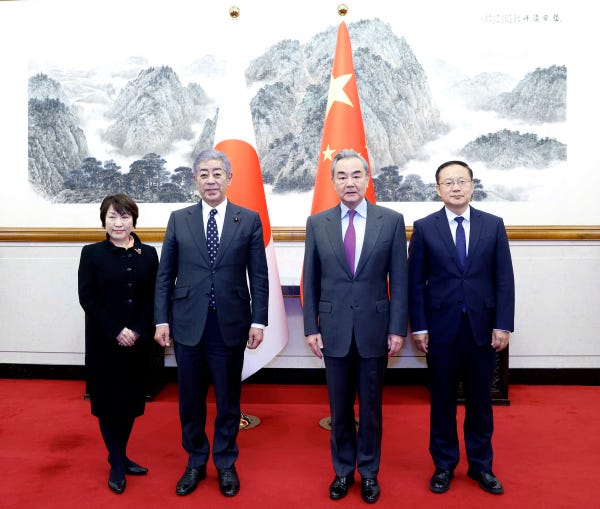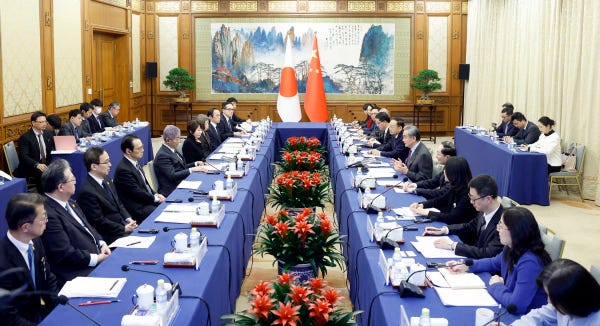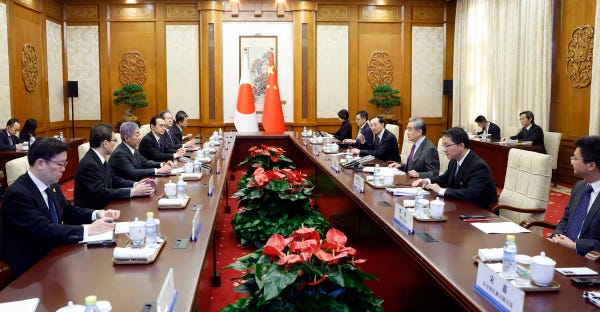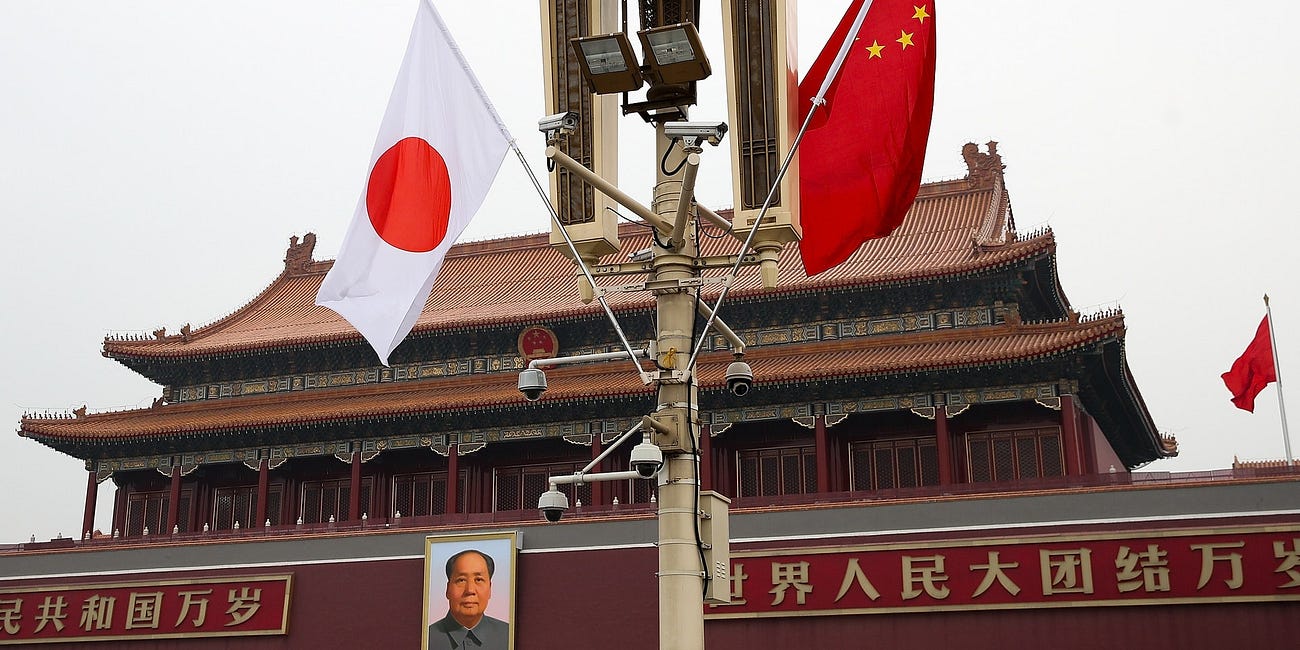Christmas for China-Japan relations
Finally, a substantial improvement.
I wasn’t expecting to crash your inbox so soon on Christmas, but Takeshi Iwaya, the Japanese Foreign Minister, didn’t waste any time Wednesday by landing in Beijing at 3:30am. By the end of the day, we are seeing a heartening warm-up between China and Japan in a relationship that reverberates beyond the bilateral level.
Here are my observations:
As I noted in November 2023, signals of a turnaround between China and Japan emerged after Chinese President Xi Jinping and Japanese Prime Minister Kishida Fumio met in San Francisco. Fortunately, the significant pick-up apparently accelerated under the new Japanese Prime Minister Shigeru Ishiba, who Xi met in Lima, Peru, last month. Chinese officials now cite the November 2024 meeting as the guideline for China-Japan relations.
The speed and scale of improvement is remarkable against the fragility of bilateral ties in recent years, the strengthening of the U.S.-Japan alliance (including an unprecedented Camp David summit between the U.S., Japan, & South Korea), unfavorability between their citizens, two despicable attacks against Japanese nationals on Chinese soil this year, China’s elevated rhetoric over Fukushima water discharge, bad press, and other stuff on a long list. Fukushima is now, as I observed in September, water under the bridge and relegated to the end of a Chinese press release today.
As you will read below, China apparently recognizes that the race to the bottom in public opinion must be reversed, especially among the young people, media, and think tanks between the two countries. Wang Yi’s pledge to energize numerous channels, including 260 pairs of friendly cities and encouraging studies and tours between young people, may remind optimistic commentators of Hu Yaobang’s invitation of 3,000 Japanese children to tour China.
Outsiders often get amused when they hear the Chinese say well, the Communist Party of China and the government it leads have to take into consideration its domestic public opinion on China’s foreign relations. No matter where the public opinion originates or how it has been and could be shaped, at least on operational levels, and I’m not making this up, Chinese official actors really do get wary of online criticism on them being “soft” on, for example, Japan.
In that sense, Beijing sends a positive signal and takes a crucial step forward in now publicly expecting media, think tanks, and “new media,” which in the Chinese context refers to influencers on social media, to play a constructive role in fostering friendly perceptions of one another.
I’m not familiar with Japanese public opinion, but there is no shortage of demonization against Japan on Chinese social media, and some outlets and influencers have played a significant role in spreading the hate. It will be interesting to see if they now get the signal and, if they do not, whether they will be reined in.
At a more immediately practical level, China re-instated visa-free travel for all Japanese passport holders last month. Iwaya, the Japanese top diplomat, came today with the easing of visa requirements for Chinese visitors.
The two sides, represented by Iwaya and Wang Yi, China’s top diplomat and a former ambassador to Japan, reached a 10-point consensus at the 2nd meeting of High-Level Consultation Mechanism on People-to-People and Cultural Exchanges between China and Japan, the first such meeting in five years, according to the Chinese foreign ministry.
1. vigorously promote youth exchange visits and encourage and support studies and tours between the two countries.
2. deepen cooperation in the field of education, strengthen the mutual exchange of students, and support the establishment of sister school relationships between primary and secondary schools, as well as inter-institutional cooperation between higher education institutions of both countries.
3. support cooperation in the tourism industry and introduce more facilitation measures to promote mutual visits between tourists from both countries.
4. build more bridges for exchange between friendly cities, and actively utilize mechanisms and platforms such as the China-Japan Governors Forum, China-Japan-Korea Cultural Exchange Year, and East Asian City of Culture to expand friendly exchanges between local and civil society in both countries.
5. strengthen sports exchange and cooperation, and mutually support the successful hosting of important sporting events such as the 2025 Harbin Asian Winter Games and the 2026 Aichi-Nagoya Asian Games.
6. support continued cooperation in entertainment industries including film and television, music, publishing, animation, and gaming. Facilitate mutual visits of high-level artistic groups and support the translation and publication of classic works from both countries.
7. enhance exchange and cooperation between media outlets and think tanks, playing a positive role in bilateral relations, and focus on improving public opinion and the media environment. Support both sides in developing exchange and cooperation in new media circles, and encourage positive content creators from both countries to interact with each other.
8. conduct exchanges between women's organizations to share experiences on promoting gender equality and common development. The Chinese side invites the Japanese side to participate in the Global Women's Summit commemorating the 30th anniversary of the Beijing World Conference on Women.
9. leverage the 2025 Osaka-Kansai World Expo into a platform for exchange and friendship between the peoples of both countries. The Chinese side supports Japan in hosting the event, while the Japanese side welcomes China's participation and will provide assistance for the construction and operation of the China Pavilion.
10. hold the 3rd meeting of the High-Level Consultation Mechanism on People-to-People and Cultural Exchanges between China and Japan.

China’s foreign ministry published Wang Yi’s full remarks at the meeting. All highlights are mine.
We are now holding the second meeting of the China-Japan High-Level Consultation Mechanism on People-to-People and Cultural Exchanges. First, on behalf of the Chinese government, I extend a sincere welcome to our Japanese colleagues. Recently, President Xi Jinping and Prime Minister Shintaro Ishiba met in Lima, agreeing to maintain high-level exchanges and make good use of high-level dialogue mechanisms in areas such as economy and people-to-people exchanges. Today's meeting is a concrete measure to implement the important consensus reached by our leaders. We look forward to inspiring new ideas for enhancing mutual understanding and friendly sentiments between our peoples through productive dialogue, and to gathering more consensus on expanding and deepening China-Japan people-to-people exchanges.
As close neighbors separated only by a strip of water, China and Japan have learned from each other and progressed together in over 2000 years of friendly exchanges, leaving many enduring stories. Xi'an and Luoyang bear witness to the enthusiasm of Abe no Nakamaro, Kukai, and others who traveled thousands of miles to study in Tang China. Nara and Kyoto testify to the faith of Jianzhen and Ingen, who endured hardships to spread Buddhist teachings to Japan. The historical accumulation of mutual learning and integration has made the cultures of China and Japan interconnected and similar, with people knowing and being close to each other, able to appreciate the beauty of Chinese characters, savor the aroma of green tea, and enjoy the rhythm of Tang poetry.
Fifty-two years ago, the older generation of leaders from both countries, guided by the spirit of taking history as a mirror and looking towards the future, and adhering to the Eastern wisdom of seeking common ground while reserving differences, promoted the normalization of diplomatic relations between China and Japan, opening a new chapter in people-to-people exchanges between the two countries. At its peak, personnel exchanges between China and Japan reached 12 million visits annually, with over 1,000 flights operating between the two countries weekly. From these vibrant exchanges and interactions, we continuously discover the contemporary value and historical significance of the close ties between our peoples and cultures, laying a solid foundation for people-to-people connectivity between China and Japan in the new era.
Under the direct concern of the leaders of both countries, the China-Japan High-Level Consultation Mechanism on People-to-People and Cultural Exchanges was established in 2019. The mechanism's task is to promote China-Japan people-to-people exchanges, foster people-to-people connectivity, and provide cultural support for building and developing China-Japan relations that meet the requirements of the New Era. Over the past five years, the people of both countries have helped each other and overcome difficulties together during the pandemic, interpreting the neighborly friendship of "different mountains and rivers, but we share the wind and moon under the same sky." The two sides have also mutually supported the Tokyo Olympics, Beijing Winter Olympics, and Hangzhou Asian Games, held the China-Japan Cultural and Sports Exchange Promotion Year, and built more bridges for friendly exchanges between the people. On the other hand, influenced by geopolitical, ideological, and other factors, the national sentiment between the two countries has not been ideal in recent years, and the phenomenon of low mutual favorability deserves attention. Achieving the goal of "creating a higher level of people-to-people connectivity and making China-Japan relations warmer and more heartening" proposed at the first meeting of the mechanism still requires significant effort.
Colleagues and friends,
China-Japan relations are currently at a crucial period of improvement and development. Guided by the important consensus reached by the leaders of both countries, to comprehensively advance the China-Japan strategic and mutually beneficial relationship and strive to build constructive and stable China-Japan relations that meet the requirements of the new era, sincere cooperation from both sides is needed. This cannot be separated from drawing wisdom from over two thousand years of exchanges and tapping into the momentum in our common cultural values.
We must persistently expand two-way personnel exchanges, using the more than 260 pairs of friendly cities between the two countries as fulcrums and the rich tourism and cultural resources of each country as leverage, to allow more and more people from both countries to come closer, witness each other's development and changes firsthand, and personally feel the friendly sentiments between us. China has already implemented a trial visa-free policy for Japan, and both sides can adopt more facilitation measures to create more favorable conditions for promoting exchanges between the peoples of the two countries. The baton of China-Japan friendship must and will eventually be passed on to the younger generation. We should especially emphasize youth exchange visits, create more topics and projects suitable for young people, promote studies and tours to each other's countries for youth and adolescents, and cultivate new forces to maintain friendship between the peoples of the two countries and promote exchanges and cooperation.
We should innovate while maintaining tradition to enrich the content of exchanges, grasp the changing trends in fields such as education, arts, entertainment industries, and sports, and combine tradition with modernity to open up new tracks for exchanges and cooperation, seeking more emotional and value identification from people-to-people exchanges. China's culture of "valuing harmony and seeking great unity" has many points of convergence with Japan's culture of "wa" (harmony). We should inherit the Asian spirit and Eastern wisdom of valuing harmony, harmony without sameness, and working together in harmony. The Harbin Asian Winter Games, Osaka World Expo, and Aichi-Nagoya Asian Games will be held successively in our two countries, and we can support each other and drive civil exchanges.
We should create a healthy and rational public opinion environment, establish correct and objective mutual perceptions, support more positive exchanges between think tanks and scholars of the two countries to build consensus for the healthy development of bilateral relations; guide the media of both countries to establish correct orientations, report objectively and accurately on each other's countries, avoid negative hype, create high-quality and influential media products, and use new media channels to tell the stories of both countries in a more vivid and lively way, stimulating the positive willingness of the people of both countries to understand each other. This year marks the 60th anniversary of the mutual dispatch of resident correspondents between China and Japan. We look forward to the continued tireless efforts of media professionals from both countries to promote friendship and mutual trust between our peoples.
Next year marks the 80th anniversary of the victory of the Chinese People's War of Resistance against Japanese Aggression and the World Anti-Fascist War. The war of aggression launched by Japanese militarism at that time brought profound disasters to the people of China and other victimized Asian countries, and the Japanese people also suffered deeply. At this important juncture 80 years after the war, Japan once again faces questions of history and morality. We should not forget the past, as it serves as a guide for the future. Remembering this history is to draw lessons from it and cherish the hard-won peace. We hope and believe that Japan will once again demonstrate its determination for peaceful development and work with China to promote the healthy and stable development of China-Japan relations in the spirit of "facing history and opening up the future."
I sincerely hope that through today's meeting, both sides will communicate in depth, exchange views frankly, fully leverage the role of the China-Japan High-Level Consultation Mechanism on People-to-People and Cultural Exchanges, plan and coordinate diverse China-Japan people-to-people exchanges, and lead China-Japan people-to-people exchanges to open up a new pattern that is deeper, broader, and closer.
Iwaya is described by a Chinese official readout as saying
Both Japan and China are guided by the important consensus reached by the leaders of the two countries to build constructive and stable Japan-China relations. They will further strengthen communication, reduce pending issues, and expand cooperation in various fields. Japan and China have a history of friendly exchanges spanning over 2000 years, with rich and diverse exchanges in various areas. The friendship between countries lies in the affinity between their peoples. Japan is willing to work with China to enhance the quality of people-to-people exchange programs, deepen friendly city interactions, and mutually adopt more measures to facilitate personnel exchanges.
Besides the high-level consultation, the two top diplomats also had a bilateral meeting, where China’s foreign ministry reported
Wang Yi stated that last month, President Xi Jinping and Prime Minister Shintaro Ishiba held a meeting in Lima, where both sides agreed to comprehensively advance the China-Japan strategic and mutually beneficial relationship in accordance with the principles and directions established in the four China-Japan political documents. They aim to build constructive and stable China-Japan relations that meet the requirements of the new era, clearly defining the direction for future efforts by both sides. China and Japan are close neighbors, and the significance of their relationship extends beyond bilateral ties. When China-Japan relations are stable, Asia becomes more stable; when Asia is stable, it can play a more important role in the world. It is hoped that Japan will work together with China to take history as a mirror, not forget the original intention, eliminate interference, gather consensus, adhere to the correct positioning of the strategic and mutually beneficial relationship, and abide by the important consensus of "being cooperative partners and not posing threats to each other," jointly promoting the healthy and stable development of China-Japan relations along the correct track.
Wang Yi proposed six points of view on advancing the next steps in China-Japan relations:
First, calibrate strategic perceptions. It is hoped that Japan will follow the trend of the times, view China's development objectively and with goodwill, and pursue a positive policy towards China.
Second, maintain mutual trust between both sides. Adhere to the four China-Japan political documents to ensure that the foundation of China-Japan relations is not damaged or shaken. Japan should keep its promises and maintain credibility on major sensitive issues such as history and Taiwan.
Third, strengthen communication and dialogue. Continue to conduct exchanges at various levels and through various channels to enhance mutual understanding and trust.
Fourth, persist in win-win cooperation. Explore the potential for cooperation in emerging fields and jointly maintain the stability of global industrial and supply chains and a fair and open trade and investment environment.
Fifth, enhance people-to-people exchanges to consolidate the social and public opinion foundation of China-Japan friendship.
Sixth, properly handle contradictions and differences, avoiding letting differences define or even hijack the bilateral relationship.
Iwaya is described by a Chinese official readout as saying
The two countries’ leaders' meeting in Lima has set the direction for both countries' efforts. Japan is willing to work with China to enhance mutual trust, coordinate cooperation, increase positive agenda items in bilateral relations, reduce pending issues, and properly manage differences. Japan aims to comprehensively advance the Japan-China strategic and mutually beneficial relationship and build constructive and stable Japan-China relations. Japan adheres to the principles of the Japan-China Joint Communique and respects and understands China's position on the Taiwan issue. Regarding historical issues, Japan continues to uphold the clear stance expressed in the "Murayama Statement," expressing deep remorse and heartfelt apology. There is enormous potential for pragmatic cooperation between Japan and China, hoping to create more visible results that would better benefit the people of both countries. Thanking China for granting visa-free travels to Japanese citizens and announce that Japan would further relax its visa policies to facilitate personnel exchanges between the two countries. The improvement of Japan-China relations presents a strategic opportunity for both countries and holds significant importance for Asia and the world. Japan is willing to work hand in hand with China to jointly promote regional peace and prosperity.
Kyodo reports that Iwaya also conveyed to Wang during their talks in Beijing his serious concerns over intensifying Chinese military activities and demanded the removal of a new buoy Japan confirmed in its exclusive economic zone off a remote southwestern island.
Iwaya also met Li Qiang, the Chinese Premier.
China’s foreign ministry reported
Li Qiang stated that China-Japan relations are currently at a crucial period of improvement and development. Last month, President Xi Jinping and Prime Minister Shintaro Ishiba held a meeting in Peru, where both sides unanimously agreed to work together to comprehensively advance the China-Japan strategic and mutually beneficial relationship, striving to build constructive and stable China-Japan relations that meet the requirements of the New Era. China is willing to work with Japan to grasp this correct direction, implement the important consensus reached by the leaders of both countries, promote the continued healthy development of bilateral relations, and achieve more new results in practical cooperation.
Li Qiang pointed out that China and Japan are neighbors separated only by a strip of water, and are neighbors that cannot be moved away. The solemn commitment to "be cooperative partners and not pose threats to each other" is a promise made jointly by both countries. It is hoped that Japan will move in the same direction as China, adhere to the principles established in the four China-Japan political documents, face history while looking towards the future, constructively and properly manage differences, and maintain the overall situation of China-Japan relations. Currently, as global development faces increasing instability and uncertainty, both sides should expand economic and trade relations, deepen mutually beneficial cooperation, and better benefit the enterprises and peoples of both countries. As the friendship between countries lies in the affinity between their peoples, both sides should further strengthen people-to-people exchanges to consolidate the foundation of friendship.
Iwaya also met Liu Jianchao, Minister of the International Department of the Communist Party of China (IDCPC).
The IDCPC says in a statement
Both sides believe that the China-Japan relationship holds significance beyond bilateral relations. They agree to effectively implement the important consensus reached between President Xi Jinping and Prime Minister Shintaro Ishiba, strengthen high-level exchanges and dialogue at various levels and in various fields, enhance mutual understanding, deepen people-to-people friendship, and promote close personnel exchanges. They aim to guide the people of both countries to view China-Japan relations with mutual respect, appreciation, and achievement. The two sides will comprehensively advance the China-Japan strategic and mutually beneficial relationship, injecting more stability into the world. The ruling parties should strengthen dialogue, deepen understanding, and establish correct perceptions.
Japanese Father’s Heartfelt Letter After Son Stabbed in Shenzhen
After the tragic stabbing of a 10-year-old Japanese boy in Shenzhen, southern China, at the hands of a Chinese stranger, a poignant letter, reportedly written by the boy's father, circulated widely on Chinese social media. The letter moved many to tears before censors eventually removed it.
Fukushima water under the bridge between China, Japan
In November last year, China and Japan agreed to “work constructively to find a proper solution” to the discharge of what Beijing insists on calling “nuclear-contaminated water” but Tokyo and the International Atomic Energy Agency call Advanced Liquid Processing System (ALPS)-treated water
China cracks down on hate speech against Japan
Over the weekend, almost all of China’s major online platforms announced, respectively, that they are cracking down on hate speech against Japan, following a deadly stabbing against a Japanese school bus on Monday.
Shi Yinhong's Sino-Japanese Rapprochement and "Diplomatic Revolution" that never materialized
As the attack and killing of a Japanese 10-year-old schoolboy in southern Shenzhen again tests China-Japan relations to the limit, I can’t help but think of a well-known media storm two decades ago. Ma Licheng of the People’s Daily newspaper and Shi Yinhong, a grand strategist at the Renmin University of China, advocated for “new thinking” toward Japan …











